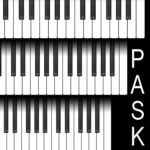Summary of experiences
‘You need to allow yourself at least a couple of days ……to begin the journey of discovery of exactly what it is that you have been missing, and the unnecessary obstacles you have been facing all of your life. Trust me when I tell you that it is lot more profound than merely “stretching” a distance between any 2 digits.’…. Christopher Donison, Dec 2006.
From Professor Kathryn-Ananda Owens who makes use of a DS5.5® in her teaching at St Olaf College, Minnesota: ”It has been a huge boon to us, both pedagogically and as a resource for students. My favorite story is from a piano performance major, who couldn’t believe that playing the piano didn’t have to hurt. The instrument restored her joy for piano repertoire. She had been preparing to change over to harpsichord due to keyboard size issues. I will never forget the day she first played a Chopin ballade on the DS5.5. She literally could not stop beaming.’
Pianists with smaller hands – particularly those with maximum hand spans from thumb to 5th finger of less than 8.5 inches (21.6 cm) – overwhelmingly report how much easier it is to play on a narrower keyboard.
Importantly, these pianists report that they have a much greater ability to focus on the music itself, rather than on overcoming technical obstacles.
Almost without exception, they adapt very quickly to the stretto keyboard – generally within a few hours. Once adapted, for pieces they can play on the conventional keyboard, the pianist is able to swap back and forth between different sized keyboards as needed.
A collection of quotes and personal stories from many pianists and teachers can be found here: https://paskpiano.org/wp-content/uploads/2022/10/PASK-Quotes-and-stories_October-2022.pdf
Survey of pianists - 2012
Rhonda Boyle (2012) conducted a survey of 22 pianists who play, or have played, stretto keyboards in North America and Australia. The results were consistent with comments previously recorded by Carol Leone, Chris Donison and others. Respondents reported improvement with many of the 22 skills listed. They were most likely to report ‘dramatic’ or ‘considerable’ improvement with:-
- ability to hold down notes as intended
- feeling of power where needed
- fast passages of octaves or large chords
- time taken to master technically difficult passages.
Other skills for which more than 50% of those who responded rated the perceived degree of improvement as ‘considerable’ or ‘dramatic’ were:
- leaps
- legato playing
- broken octaves
- broken chords/arpeggios
- changes of hand position
- time taken to learn new repertoire
- awkward or non-ideal fingering
- accuracy
- overall feeling of security
- balance
This survey did not find any significant difference in perceived improvements among the group with the smallest hands (<7.5 inches, or 19.1 cm) compared to those with slightly larger hands (between 7.5 and 8 inches).
For a pianist with a hand span closer to the average for females, changes may be more subtle, such as the improved legato playing, musical line and phrasing and reduced tension when playing octaves. This group of pianists, who can pay a 10th for the first time, also find that are able to tackle repertoire normally the preserve of male pianists, such as works by Rachmaninoff and other Russian composers, Ravel, and advanced Chopin or Liszt works requiring larger spans to play effectively.
The other pages under Feedback from pianists describe these improvements in more detail.
A recent study (Chi et al, 2021) in Sydney, Australia, involved a number of pianists playing exercises and repertoire on three different sized keyboards. All participants except one preferred one of the two smaller sizes (6.0 inch or 5.5 inch octave keyboards), including those participants with hand spans above 8.5 inches (21.6 cm).
Feedback from conferences and other events
A Walter upright piano with DS5.5® keyboard was available at the 2011 Australasian Piano Pedagogy Conference for delegates to try. Those who played long enough to feel sufficiently comfortable with this size found certain skills to be easier. Pianists who reacted positively included males with hand spans of more than 8 inches (20 cm). ‘Octave passages’ and ‘balance and voicing’ were most commonly noted as being easier. At the 2013 and 2015 Australasian Piano Pedagogy Conferences, and the 2016 EPTA conference in Reykjavik, a Kawai GM12 grand piano with 15/16 (6.05 inch octave) keyboard was available. Delegates trying it found that the time needed to adjust from the conventional keyboard was minimal.
At the 2015 APPCA conference, six of Melbourne’s top professional pianists took part in a recital and panel discussion using the Kawai GM12. Their hand spans ranged from 7.1 (18.0 cm) to 9.2 inches (23.4 cm) and they had all had very little practice time on the smaller sized keys. For the pieces they chose, ALL pianists discovered advantages when playing the 15/16 keyboard. For those with the smallest spans, the benefits were profound and wide-reaching, while for those males with the largest hands, they found larger intervals (9ths and 10ths) much easier, as well as voicing of large chords such as in a Rachmaninoff Etude. This experience suggests that keyboards with narrower keys would benefit a very large majority of pianists at least for some repertoire – including even those with spans of more than 9 inches! It also indicates that repertoire written by some very large-handed male composers – Rachmaninoff, Vine, Grainger, Liszt – is inaccessible to many. Even male pianists with ‘average’ hands are able to perform some of their works more successfully on a keyboard with narrower keys.
A similar recital by four distinguished pianists/pedagogues in the US was held at the NCKP conference in Chicago in 2017.
There have been many other events in the USA and Canada, and more recently in Germany, where pianists have had the opportunity to try alternatively sized keyboards. Some of these are mentioned here: https://paskpiano.org/performances-and-conferences/
Literature covering tips for small-handed pianists
Looking at the issue from the perspective of a small-handed pianist, there is a wealth of information available about how to ‘adapt’ to a keyboard that is too big. Some of the tips promoted by so-called ‘experts’ are not evidence-based, give false hope to many, and may even be harmful.
Although its focus is not about alternatively sized keyboards as such, an excellent book has recetly been published by Oxford University Press: Adaptive Strategies for Small-Handed Pianists (Deahl & Wristen, 2017). It provides a great summary of the many ‘work-around’ strategies that small-handed pianists need to adopt and gives the clear message that the issues are not trivial. The title does not totally convey the breadth of what is covered – the introductory chapters deal with the evolution of the piano and piano repertoire, anatomy and biomechanical principles relevant to piano playing, the wide-ranging problems of small-handed pianists and common maladaptive tendencies.


